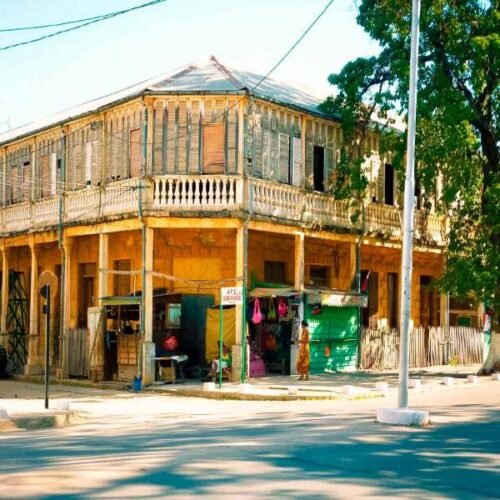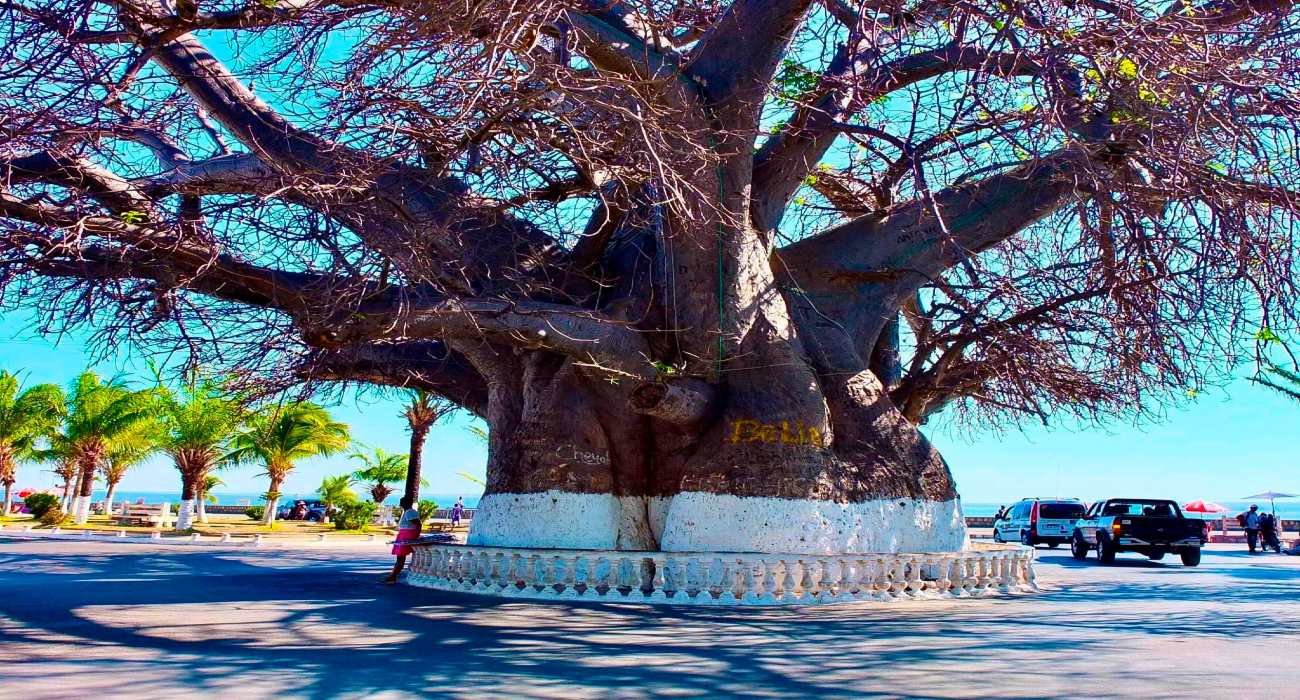Overview
Set at the mouth of the majestic Betsiboka River and framed by the warm waters of Bombetoka Bay, Mahajanga (also spelled Majunga) is a city where tradition, history, and coastal charm come together. As Madagascar’s third-largest city and second-busiest port after Toamasina, Mahajanga is a vital gateway to the island’s northwest.
Often overlooked in favor of the beaches of Nosy Be or the rainforests of Andasibe, Mahajanga is a city that rewards the curious. With its melting pot of cultures, colorful architecture, and easy access to some of Madagascar’s most spectacular natural parks and geological formations, Mahajanga offers a unique slice of Malagasy life—vibrant, complex, and deeply tied to both land and sea.
Location
Mahajanga is located on the northwestern coast of Madagascar, sitting at the entrance to Bombetoka Bay—an expansive estuary where the Betsiboka River empties into the Mozambique Channel. The city is approximately 550 km north of Antananarivo and is connected by both road and regional flights.
This strategic coastal position has made Mahajanga an important trading post for centuries, with deep ties to East African, Arab, Indian, and French influences that still shape the city’s culture and cuisine today.


A Brief History of Mahajanga
From Sakalava Kingdom to Colonial Port
The roots of Mahajanga trace back to the late 17th century, during the reign of Andriamandisoarivo (1685–1718), a powerful Sakalava king and founder of the Boina Kingdom. The city, then known as Mozangaye, quickly rose to prominence as a key port for regional and international trade.
This early prosperity was largely thanks to the Antalaotra, seafaring traders of mixed Arab, Comorian, and African origin who made Mahajanga a commercial hub. They traded zebu cattle, wax, silk, rice, spices, timber, slaves, and precious stones with merchants from East Africa, the Middle East, and Europe.
Under the reign of the celebrated Queen Ravahiny in the late 18th century, Mahajanga flourished. She fostered alliances with Andrianampoinimerina, king of the Merina in the central highlands, though her successors struggled to maintain political unity.
Colonial Turbulence and Resistance
In 1824, Merina King Radama I annexed Mahajanga into his growing kingdom. This foreign rule was met with strong resistance from the local Sakalava population. In 1825, a major fire ravaged the city amid ongoing unrest. The tension lasted until 1835, when the Sakalava King Andriantsoly fled to Mayotte, marking the end of Sakalava rule.
The city later fell under French control. Declared a French protectorate in 1841, Mahajanga—along with Nosy Be and Nosy Mitsio—served as a colonial stronghold. In 1895, the first French expeditionary ships arrived, laying the foundation for full colonization.
Today, the city remains a cosmopolitan blend of Malagasy, Arab, Indian, African, and French heritage—a legacy visible in its markets, mosques, churches, and food.
When to Go
Mahajanga has a hot and dry tropical climate, making it a year-round destination, but some months are more pleasant than others depending on your travel goals.
🌞 Best Season: May to October (Dry Season)
-
Ideal for sightseeing, road trips, and exploring nearby parks
-
Temperatures average around 25–30°C, with little to no rain
-
Great for beach days and trekking
🌧 Rainy Season: November to April
-
High humidity and daytime temperatures over 35°C
-
Short, intense tropical storms common
-
Lush landscapes but some roads may be hard to navigate
If you’re planning to explore Ankarafantsika National Park or visit the Cirque Rouge, the dry season is highly recommended.
What to Do and See in Mahajanga
1. Discover the Charm of the City Itself
While Mahajanga may not be Madagascar’s premier holiday beach town, it has a lively, dusty charm with colonial-era buildings, bustling markets, and a relaxed rhythm.
-
Stroll the waterfront promenade in the early morning or evening
-
Visit the iconic baobab tree near the center, a local landmark
-
Enjoy sunset views over Bombetoka Bay, a favorite pastime for locals and visitors
The city is cosmopolitan, with communities of Indians, Comorians, Arabs, and Malagasy Sakalava, making for a unique culinary scene rich in spices, grilled seafood, samosas, and Indian-style curries.
2. Sunset at Cirque Rouge
Just outside the city lies one of Madagascar’s most striking geological formations: the Cirque Rouge, or Red Circus.
-
A dramatic natural amphitheater of eroded red, ochre, and pink sandstone cliffs
-
The best time to visit is sunset, when the rocks glow with vivid color
-
Easily reachable by car or tuk-tuk from Mahajanga’s center
It’s the perfect place for photography or a short afternoon hike.
3. Relax at Antsanitia Beach
Located about 20 km north of Mahajanga, Antsanitia Beach is considered the most beautiful in the region:
-
Golden sand, palm trees, and calm waters ideal for swimming
-
Great for relaxing, birdwatching, and local canoe tours
-
A few ecolodges and bungalows available for peaceful overnight stays
If you’re looking for a quiet beach escape without the crowds of Nosy Be, Antsanitia is a fantastic option.
4. Explore Ankarafantsika National Park
About 2 hours’ drive from Mahajanga, Ankarafantsika National Park is one of Madagascar’s top wildlife destinations and can easily be visited on a day trip or overnight excursion.
-
Home to 8 species of lemurs, including the famous Coquerel’s sifaka
-
Over 120 species of birds, making it a birdwatcher’s paradise
-
Trails through dry deciduous forests, lakes, and canyons
-
Don’t miss the Lac Ravelobe, where you might spot crocodiles basking in the sun
Guided treks can be arranged at the park entrance, and simple accommodation is available nearby.
5. Visit the Anjohibe Caves
A hidden natural wonder, the Anjohibe Caves are located about 4–5 hours from Mahajanga, accessible via a rough and dusty track (4WD required).
-
Massive limestone cave systems with stalactites and underground pools
-
Natural swimming holes, waterfalls, and a refreshing change from the city heat
-
Lemurs and other wildlife can be spotted en route
Due to the distance and road conditions, a 2-day excursion is recommended. Bring a guide, camping gear, and supplies—or arrange the trip through a local operator.
6. Day Trip to Katsepy
Across the bay from Mahajanga is Katsepy, a small village with a historic lighthouse, quiet beach, and rich marine life.
-
Reachable by boat across the Bombetoka estuary
-
Home to lemur colonies, mangrove ecosystems, and local fishing communities
-
Ideal for a half- or full-day adventure
It’s a great place to escape the heat of the city and discover Sakalava coastal culture.
7. Multi-Day Expeditions: Namoroka and Bay of Baly
For intrepid travelers, the Namoroka National Park and the Bay of Baly offer some of the most unique landscapes and ecosystems in Madagascar.
-
Both located further north of Mahajanga and accessible only by off-road vehicles or organized tours
-
Expect limestone tsingy formations, rare lemurs, birds, and untouched beaches
-
Minimum 5 days recommended for both parks, including travel time
These parks are a must for nature lovers looking to get truly off the beaten path.
Final Thoughts: Why Visit Mahajanga?
Mahajanga isn’t the polished, resort-filled tourist hub of Nosy Be. Instead, it offers something more authentic, more grounded—and, for the right traveler, far more rewarding.
-
A cosmopolitan atmosphere rooted in centuries of trade and migration
-
Easy access to unique natural wonders—from tsingy and caves to baobabs and beaches
-
A base for both culture and adventure, with the warm hospitality of the Sakalava people
Whether you come for the wildlife, the geology, or just to experience another side of Madagascar, Mahajanga delivers—with less noise, fewer crowds, and more soul.
Planning a trip to Madagascar’s northwest? Don’t skip Mahajanga. It may not be the easiest place to get to, but that’s exactly why it stays so special.
What to see in Mahajanga
Majunga by itself is not the best holiday destination, it is very hot (it can easily reach 35-40 degrees), a very dusty city but with a certain charm. Mahajanga is however the base for visiting many places that deserve to be visited.
A day could begin by visiting the fantastic beach of Antsanitia, the most beautiful in the area, to finish at sunset at the Cirque Rouge, the Red Tsingy of Mahajanga.
Many tourists who venture in these parts do so for the National Park of Ankarafantsika National (2 hours drive) and for the splendid caves of Anjohibe with its natural pools and its lemurs. To visit the caves consider at least 2 days (4/5 hours each way of very rough road).
It is also worth mentioning Katsepy with its lighthouse, its beach and several species of lemurs.
Although far and difficult to reach, try not to miss the National Parks of Namoroka and the Bay of Baly (minimum 5 days to visit both parks).

